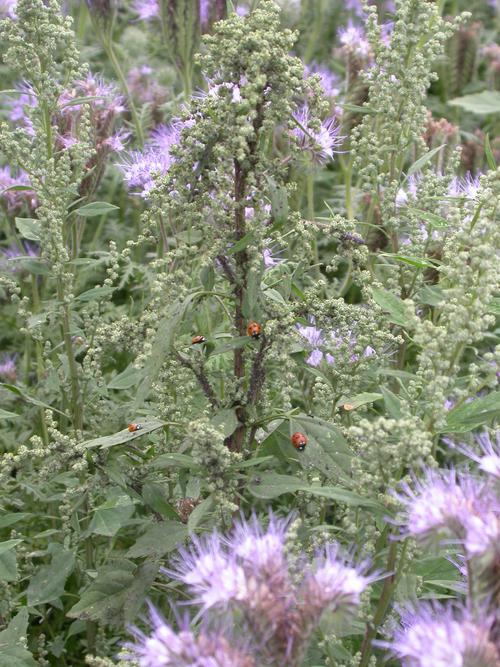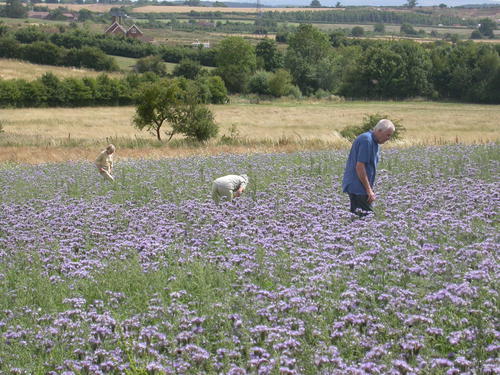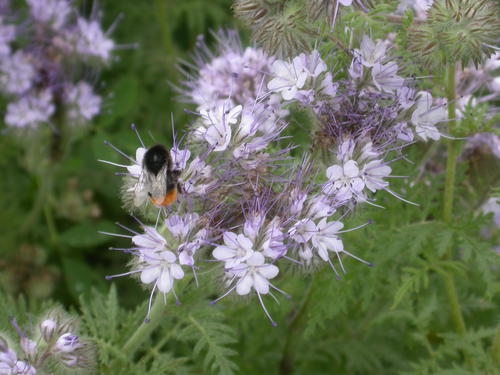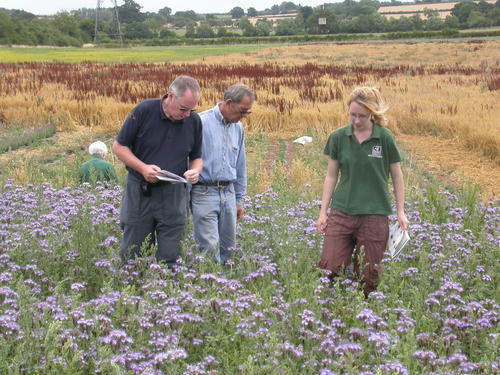Lower Smite Farm: bumble bee and ladybird surveys 27th July 2010. First trial
Caroline Corsie, Andrew Conway and volunteers
Farming and visiting Roving Volunteers surveyed four areas of Lower Smite Farm, the Worcestershire Wildlife Trust’s headquarters, in late July 2010 for bumblebees and ladybirds. The results will contribute to the development of an effective long term monitoring strategy for the farm. The overall aim is to determine whether changes in farming practice can halt the decline in bumblebees, earthworms, soil organic matter and farmland birds. All the survey plots were situated in the 6ha field known as ‘Oak Tree’ which entered organic conversion on August 5th 2009.
METHODS
Bumblebees were counted in four different habitat/crop types: Phacaelia, Fodder Radish, Spring Oats and Charlock (fallow).
Bumblebees: three volunteers slowly paced 40 steps (20m) in each habitat counting all bumblebees seen in the area covered by their outstretched arms (approx 1.4m) so each surveyed an area of approximately 28m2. Volunteers were approximately 40 paces (20m) apart. The average of the three counts was used for each habitat type (clearly a rough method but it did give results which indicated the order of magnitude of the number of bees present in each area).
Ladybirds : only the Phacaelia plot (3000m2) was surveyed. Adults and pupae were counted in twelve 1x1m squares each separated by at least 10 metres.
Flora/crop types
Phacelia Phacelia tanacetifolia: A 3000m2 (0.3ha) plot. This quick growing hardy annual green manure plant is sown at Lower Smite Farm as part of a soil improvement program. The purple/blue flowers are very attractive to bumblebees and hoverflies. It smothers weeds well and has an extensive root system that improves the soil structure. It flowers from 6-8 weeks after sowing for a period of 6-8 weeks and self seeds well.
Fodder Radish Raphanus sativus: a spring sown, late white-flowering annual brassica producing ‘tough’ seed pods which it is hoped will provide seeds for birds in January/Feb
Spring sown oats (with a lot of docks!). Sown on first year ‘in conversion’ land.
Charlock Sinapis arvensis in fallow: a prolific spring germination on fallow land
RESULTS
Phacelia: Bumblebees
Transect | No. of Bumblebees (28m2) |
Volunteer 1 | 152 |
Volunteer 2 | 217 |
Volunteer 3 | 200 |
Note: Average 189 bees per 28m2. Honey bees appeared near the edge, more bumblebees in the middle of the plot.
At the risk of infuriating the statisticians and allowing that every bee may have been counted twice, extrapolation leads to the possibility of 10,124 Bumblebees in the Phacaelia plot. (Average number of bumblebees per 28m2 = 189 ÷ 2 x 3000 (area of plot)).
Bumblebee species recorded: Buff-tailed Bumble Bee Bombus terrestris; White-tailed Bumble Bee Bombus lucorum), Red-tailed Bumble Bee Bombus lapidarius; Early Bumble Bee Bombus pratorum; Common Carder Bee Bombus pascuorum. Honey Bees were also counted. Note: the counts did not differentiate between species
Phacaelia: Ladybirds
12 plots of 1m2 were surveyed.
Ladybirds counted = 36
Average number of Ladybirds 1m2 = 3
Ladybird pupae counted = 18
Average number of ladybird pupae per 1m2 = 1.5
By extrapolation total ladybirds in Phacaelia plot (3000m2) = 9,000.
By extrapolation total Ladybird pupae in Phacaelia plot ((3000m2) = 4500
Forage Mustard: Bumblebees
Transect | No. of Bumble Bees |
Volunteer 1 | 3 |
Volunteer 2 | 5 |
Volunteer 3 | 5 |
Spring Oats (with a lot of docks!): Bumblebees
Transect | No. of Bumble Bees |
Volunteer 1 | 3 Bumble bees. 1 Honey bee |
Volunteer 2 | 4 Bumble bees |
Volunteer 3 | 4 Bumble bees |
N.B: Bees were only present on spear thistle within the spring oats or in flight.
Charlock (in fallow): Bumblebees and honeybees
Transect | No. of Honey Bees | No. of Bumble Bees |
Volunteer 1 | 24 | 2 |
Volunteer 2 | 12 | 1 |
Volunteer 3 | 5 |
Summary
The Phacaelia plot had by far the most bumble bees. Phacaelia is known to attract bees away from other plants and this could be to the detriment of adjacent crops requiring pollinating?
Ladybird counts were highest in the Phacaelia plot. However, this plot also had abundant fat hen Chenopodium album hosting dense colonies of Black Bean Aphid Aphis fabae which were attracting the predatory ladybirds - see picture.
Ladybird species were not identified though it was noted that Harlequin Ladybird Harmonia axyridis were present and Seven-spot Coccinella 7-punctata ladybirds were abundant everywhere this year.
Improvements for future surveys
Distance will be measured before walking.
Photos will be taken of bee and ladybirds to identify species.
Replicate number will increase and statistical analyses will be applied.



